Contents
Supervisely
Supervisely Alternatives
1. Encord
2. Amazon SageMaker Ground Truth
3. VGG Image Annotator
4. KeyMakr
5. Hive
6. Dataloop AI
7. Kili
8. CVAT
9. Superb AI
10. SuperAnnotate
11. Segments.ai
12. LabelBox
Supervisely Alternatives: Key Takeaways
Encord Blog
12 Best Supervisely Alternatives in 2025

With the global computer vision market reaching a market value of US$50.97 billion by 2030, technology is becoming indispensable for surviving in the modern industrial space. However, reports predict users will generate around 175 zettabytes of data by 2025, calling for robust CV software solutions to streamline the development and deployment processes.
Supervisely is a popular choice for managing large-scale CV operations among the many platforms available in the market. However, due to its high price tag, the tool may not be suitable for small—to medium-sized businesses.
This article discusses the top alternatives to Supervisely to help you choose a platform that suits your needs. The list below highlights the major solutions mentioned in the following sections.
- Encord
- Amazon SageMaker Ground Truth
- VGG Image Annotator
- Keymakr
- Hive
- Dataloop AI
- Kili
- Computer Vision Annotation Tool (CVAT)
- Super.ai
- SuperAnnotate
- Segments.ai
- Labelbox
Supervisely
Supervisely is a data labeling and model-building platform that lets you annotate images, videos, point-cloud, and Digital Imaging and Communications in Medicine (DICOM) data. It also features smart labeling tools that use artificial intelligence (AI) to automate annotation workflows.
The solution also helps with data management by offering data import and export functionalities with additional features to process complex datasets. Its collaboration tools allow you to share and manage assets with team members more efficiently through workspaces and projects.
Further, its ecosystem includes pre-built neural networks that allow you to develop high-quality machine learning models (ML models) for multiple use cases through an intuitive user interface (UI). Users can also visualize performance metrics to analyze model failures and debug issues.
Challenges
While Supervisely is a cloud-based solution for data annotation and management, it has a few limitations that make it unsuitable for specific applications.
- Challenging to use: The tool becomes difficult to learn for new users, who may become overwhelmed by the numerous options for labeling, managing, and visualizing data.
- Limited annotation methods: While Supervisely supports annotation for multiple modalities, it lacks sufficient methods to label modern data objects.
- High up-front costs: Although Supervisely offers a free community version, it falls short of the features required for large-scale projects. The Pro and Enterprise versions have an extremely high price tag, making them only accessible to larger enterprises with hefty budgets.
Due to these challenges, Supervisely is a poor option for startups in the CV industry who want a simple tool for building novel applications.
So, let’s see what alternatives are available to help new businesses get started with CV systems quickly.
Supervisely Alternatives
With Supervisely being an expensive solution, the list below mentions multiple alternatives ranked according to affordability, ease of use, annotation methods, and other data and model management features.
1. Encord
Encord is an end-to-end data-centric platform that enables you to annotate, curate, and manage computer vision datasets through AI-assisted annotation features.
It also provides intuitive dashboards to view insights on key metrics, such as label quality and annotator performance, to optimize workforce efficiency and ensure you build production-ready models faster. The platform consists of three tools that help you with high-quality data preparation for building AI applications:
- Encord Annotate: Includes basic and advanced features for labeling image data for multiple CV use cases.
- Encord Active: Supports active learning pipelines for debugging datasets and evaluating CV models.
- Index: Helps curate and manage multi-modal data.
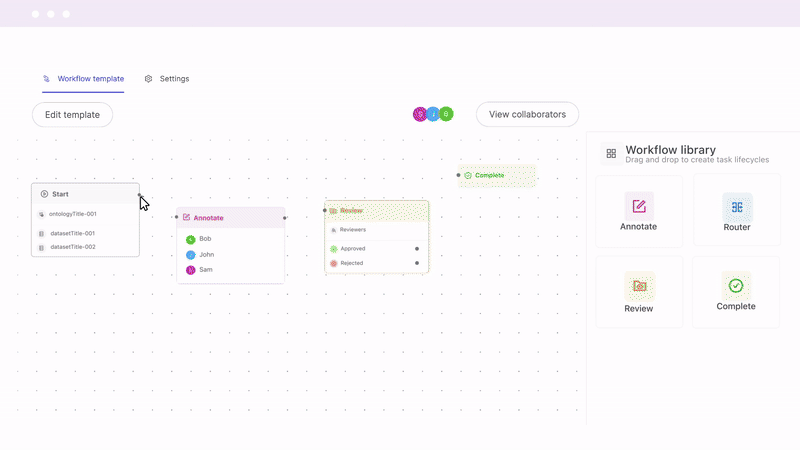
Key Features
- Ease-of-use: Encord Annotate offers an intuitive user interface (UI) and an SDK to label and manage annotation projects.
- Affordability: Encord offers multiple plans to suit different needs. It has a Starter plan for small teams, a Team plan for scaling AI models, and an Enterprise plan offering features for managing large-scale projects.
- Supported data types: The platform lets you annotate images, videos (and image sequences), DICOM, and mammography data.
- Supported annotation methods: Encord supports multiple annotation methods, including classification, bounding box, keypoint, polylines, and polygons.
Other Features
- Scalability: The platform allows you to upload up to 500,000 images (recommended), 100 GB in size, and 5 million labels per project. You can also upload up to 200,000 frames per video (2 hours at 30 frames per second) for each project. See more guidelines for scalability in the documentation.
- Collaboration: To manage tasks at different stages, you can create workflows and assign roles to relevant team members. User roles include admin, team member, reviewer, and annotator.
- Automated labeling: The platform speeds up the annotation with automation features, including:
- - Segment Anything Model (SAM) to automatically create labels around distinct features in all supported file formats.
- - Interpolation to auto-create instance labels by estimating where labels should be created in videos and image sequences.
- - Object tracking to follow entities within images based on pixel information enclosed within the label boundary.
- Integration: Integrate popular cloud storage platforms, such as AWS, Google Cloud, Azure, and Open Telekom Cloud OSS, to import datasets.
- Data security: Encord complies with the General Data Protection Regulation (GDPR), System and Organization Controls 2 (SOC 2), and Health Insurance Portability and Accountability Act (HIPAA) standards. It uses advanced encryption protocols to ensure data security and privacy.
Best For
- Teams of all sizes looking for a complete CV solution to build innovative applications.
Pricing
- Encord has a pay-per-user pricing model with Starter, Team, and Enterprise options.
2. Amazon SageMaker Ground Truth
Amazon SageMaker Ground Truth (GT) is a labeling platform that uses human feedback to speed up annotation. It also allows you to customize, monitor, and evaluate ML models for multiple use cases.
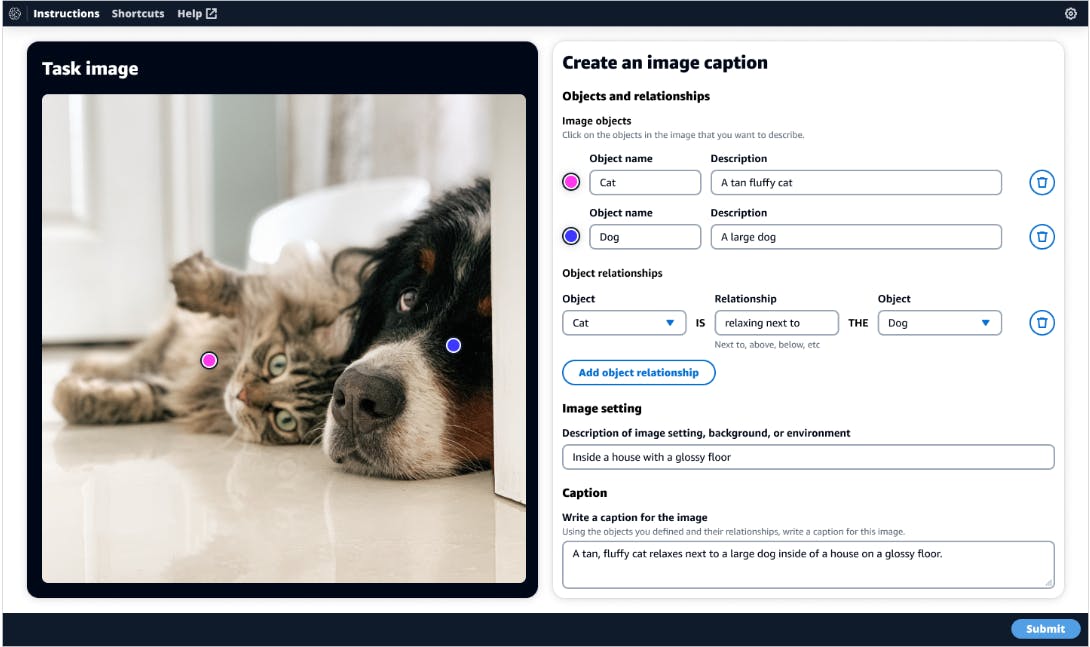
Key Features
- Ease-of-use: The platform features an intuitive UI with clear instructions to help new users with quick learning.
- Annotation Methods: SageMaker GT offers all the standard labeling methods for image classification, object detection and tracking, semantic segmentation, and text classification.
Other Features
- Reinforcement Learning with Human Feedback (RLHF): SageMaker GT allows users to enhance model training using RLHF functionality, which leverages human feedback to optimize model performance.
- Model Evaluation: The platform offers multiple metrics to evaluate large language models (LLMs), including response relevance, toxicity, bias, brand voice, and style.
- Custom Workflows: You can create customized labeling workflows through pre-defined templates for a faster annotation process.
Best For
- Enterprises looking for a solution to build multi-modal models using text and vision.
Pricing
- Pricing depends on the labeling workload.
3. VGG Image Annotator
VGG Image Annotator (VIA) is an open-source web-based labeling tool that allows users to label large datasets through a two-stage process involving automated labeling and manual review.
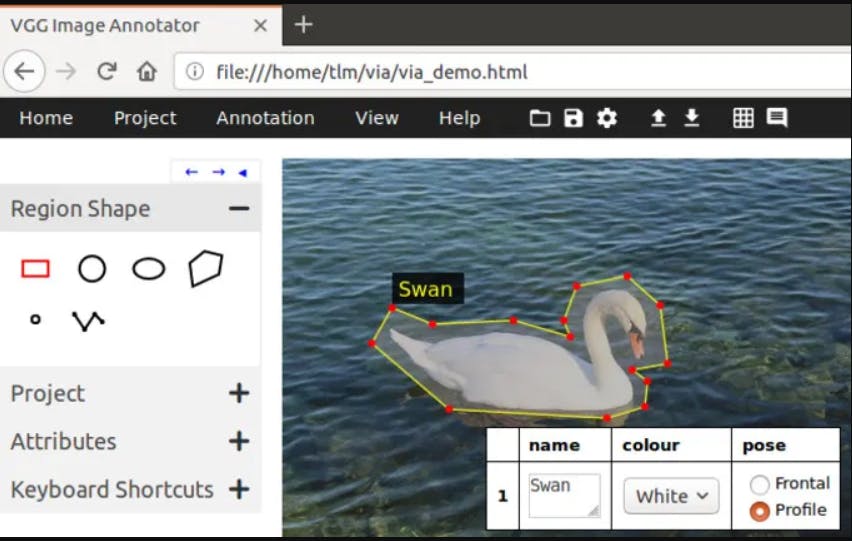
Key Features
- Affordability: VIA is free to use, making it suitable for small-scale researchers who want to experiment with multiple labeling tasks.
- Ease-of-use: The platform is straightforward, requiring no prior expertise or complex configurations.
- Annotation methods: VIA supports rectangles, circles, ellipses, polygons, polylines, and key points.
Other Features
- Supported formats: Users can import and export data in CSV and JSON formats.
- Filtering, Selection, and Update: VIA lets annotators filter, select, and update annotations to ensure high labeling quality.
Best For
- Individual researchers working on small-scale projects.
Pricing
- The tool is open-source.
.
4. KeyMakr
KeyMakr is a labeling service provider that helps users with image and video annotation. It also offers data curation services.
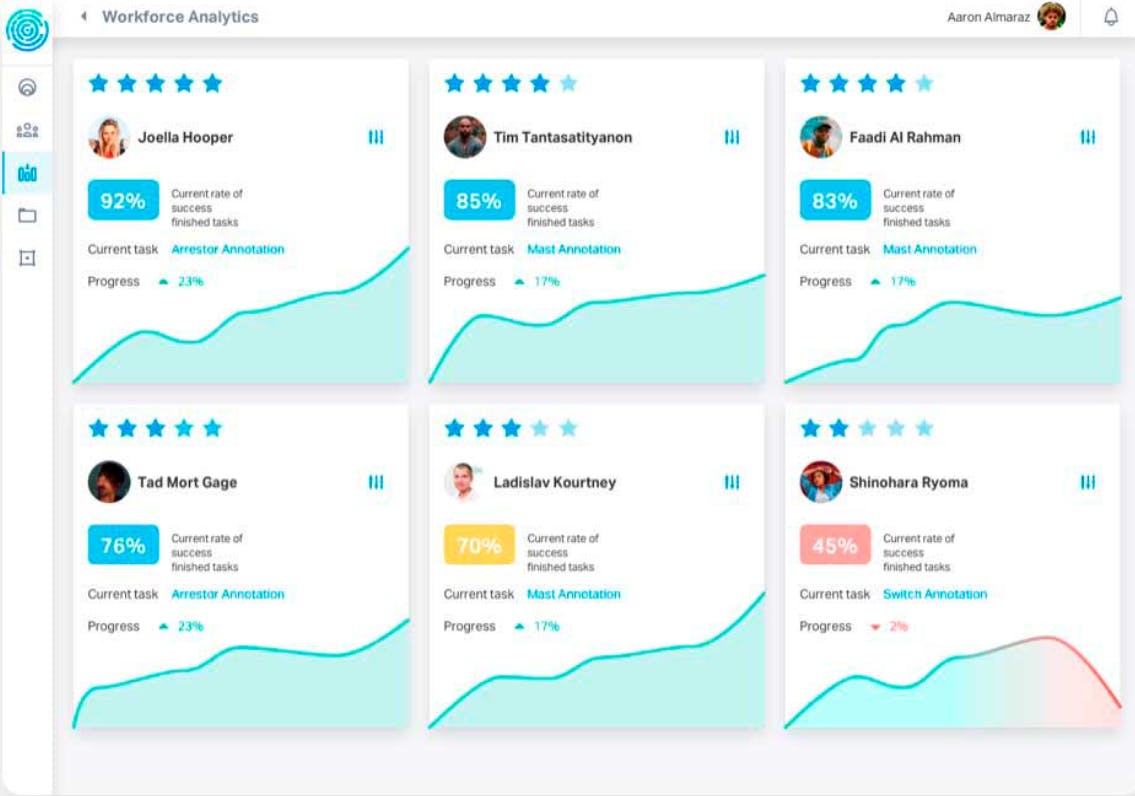
Key Features
- Affordability: KeyMakr is suitable for companies that find it expensive to hire and manage an in-house labeling team.
- Ease-of-use: Since KeyMakr handles all the labeling and technical requirements, users only need to submit their data and specify their use case.
- Annotation Methods: The service supports multiple methods, including bounding boxes, cuboids, polygons, semantic and instance segmentation, and key points.
Other Features
- Data Validation: The platform offers services to validate training data to ensure its accuracy, consistency, and relevance.
- Data Collection and Creation: KeyMakr helps you collect and create suitable data according to your requirements.
Best For
- Teams looking for a company to outsource their labeling projects.
Pricing
- Pricing is not publicly available
5. Hive
Hive is a content moderation platform that uses deep learning models to flag harmful or explicit content in images, videos, text, and audio.

Key Features
- Ease of use: Hive has an intuitive interface and a moderation dashboard that lets you visualize content and control model outputs through custom moderation policies.
Other Features
- AutoML: The AutoML feature lets you build models from scratch without using any code.
- Embeddings: The platform lets you quickly create text embeddings to augment LLMs with retrieval augmented generation (RAG).
- Search: Hive offers a flexible web search functionality where users can provide an image and get relevant links to similar images.
- Generative AI (Gen AI): Hive features APIs to generate text, images, and videos based on textual prompts.
Best For
- Teams looking for content moderation solutions to enhance application safety.
Pricing
Pricing is not publicly available.
6. Dataloop AI
Dataloop is an all-in-one platform for managing data and building models that helps you through each stage of the mode development lifecycle.
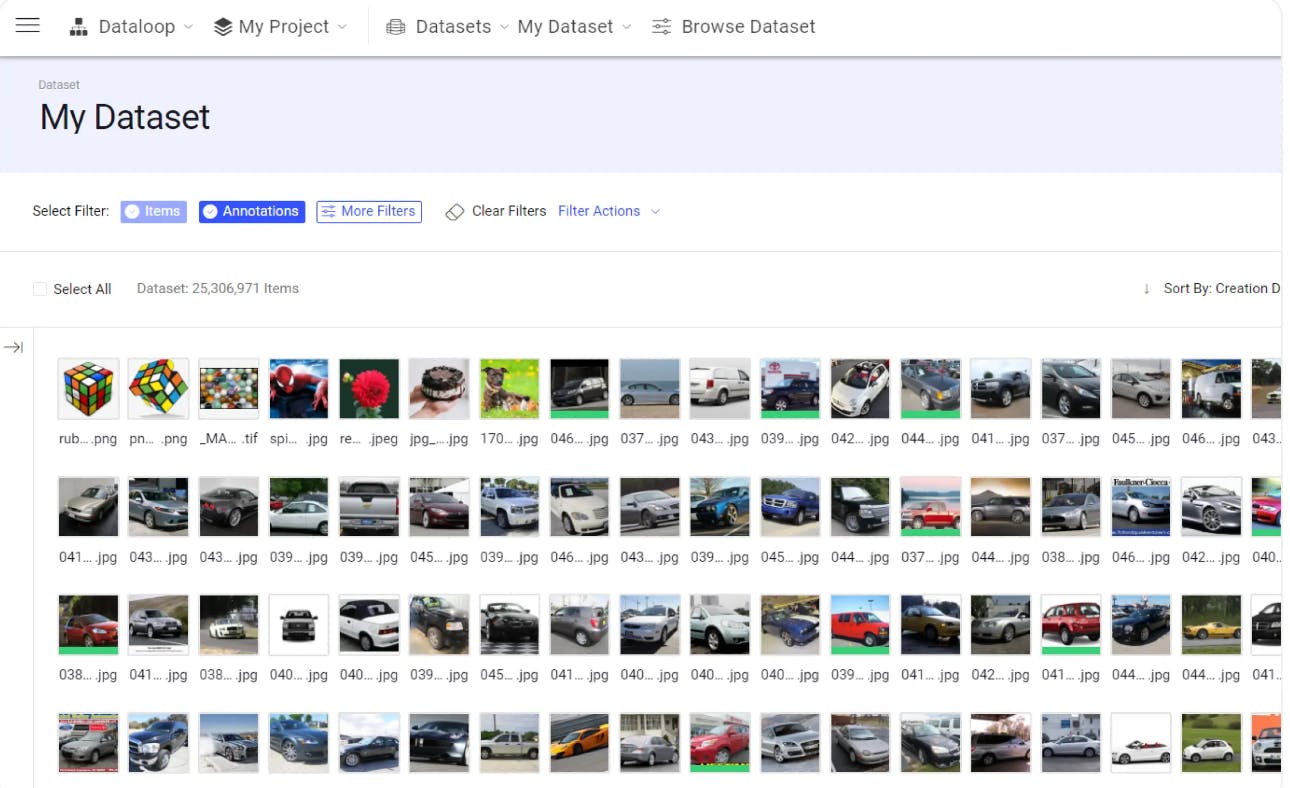
Key Features
- Ease-of-use: The platform provides a no-code UI to build data and modeling pipelines using simple drag-and-drop functionality.
Other Features
- Supported Data Types: Dataloop supports image, video, text, audio, and point cloud data.
- Active Learning Pipelines: The platform lets you create active learning pipelines to speed up annotation.
- Model Marketplace: Dataloop lets users pick the latest state-of-the-art (SOTA) models from its marketplace and use them directly in the platform for specific use cases.
- Elements: The platform enables you to add pre-built functions called elements to enhance your applications.
Best For
- Large teams consisting of data scientists, engineers, and software developers requiring strong collaboration.
Pricing
- Pricing is not publicly available.
7. Kili
Kili is a data platform for building high-qualitytraining data to create LLMs and generative AI models. It offers relevant annotation tools and quality metrics to boost annotation speed and quality.
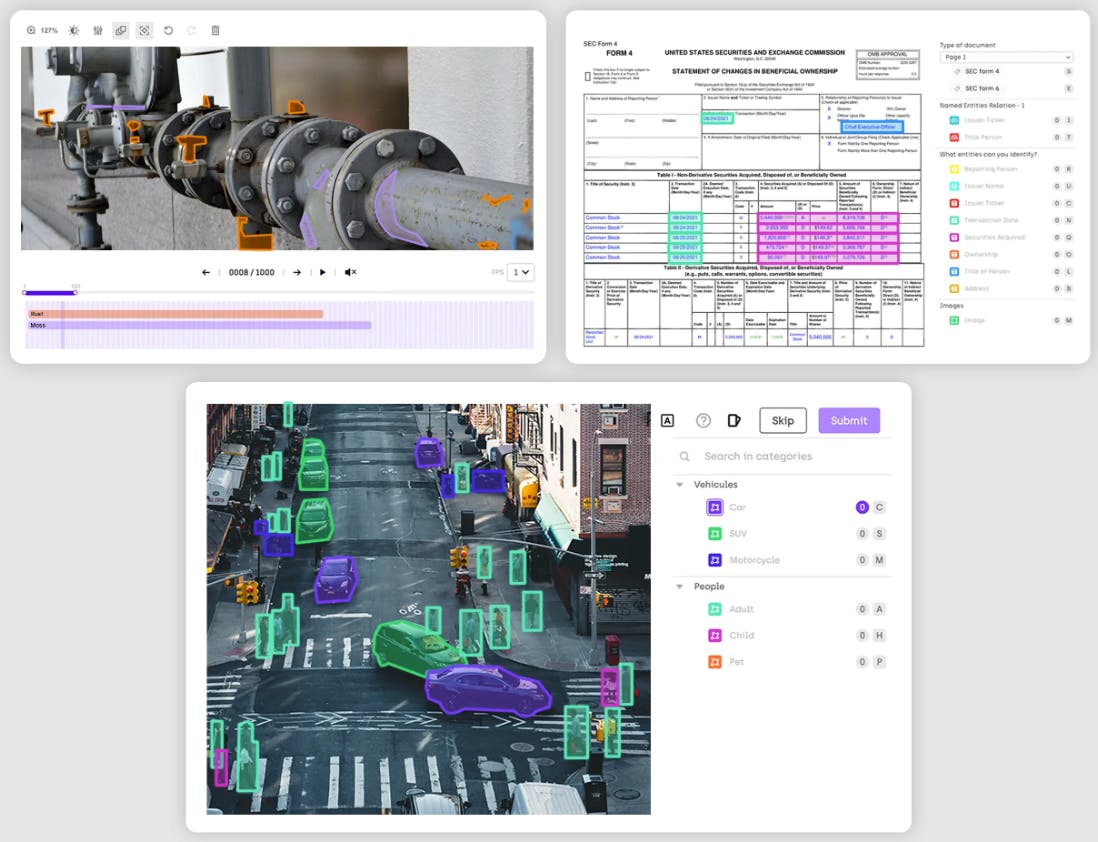
Key Features
- Affordability: Kili offers a free version suitable for small-scale projects with up to 100 annotations. The Grow and Enterprise versions feature custom prices based on your needs.
- Ease of use: The platform offers an intuitive UI for managing projects, exploring data, and analyzing annotation progress and quality.
- Annotation Methods: Kili supports bounding boxes, polygons, key points, cuboids, and landmark annotation.
Other Features
- Automation: The tool lets you pre-label textual data using ChatGPT and Segment Anything Model (SAM) to label images for semantic segmentation tasks.
- Plugins: The platform enables you to build custom plugins through its Python SDK for more efficient labeling.
Best For
- Teams looking for a labeling solution that supports CV and natural language processing (NLP) tasks.
Pricing
- Kili offers custom pricing based on specific user needs.
8. CVAT
The Computer Vision Annotation Tool (CVAT) is a solution for labeling images and videos in multiple formats. It uses modern deep-learning frameworks to boost annotation speed and quality.
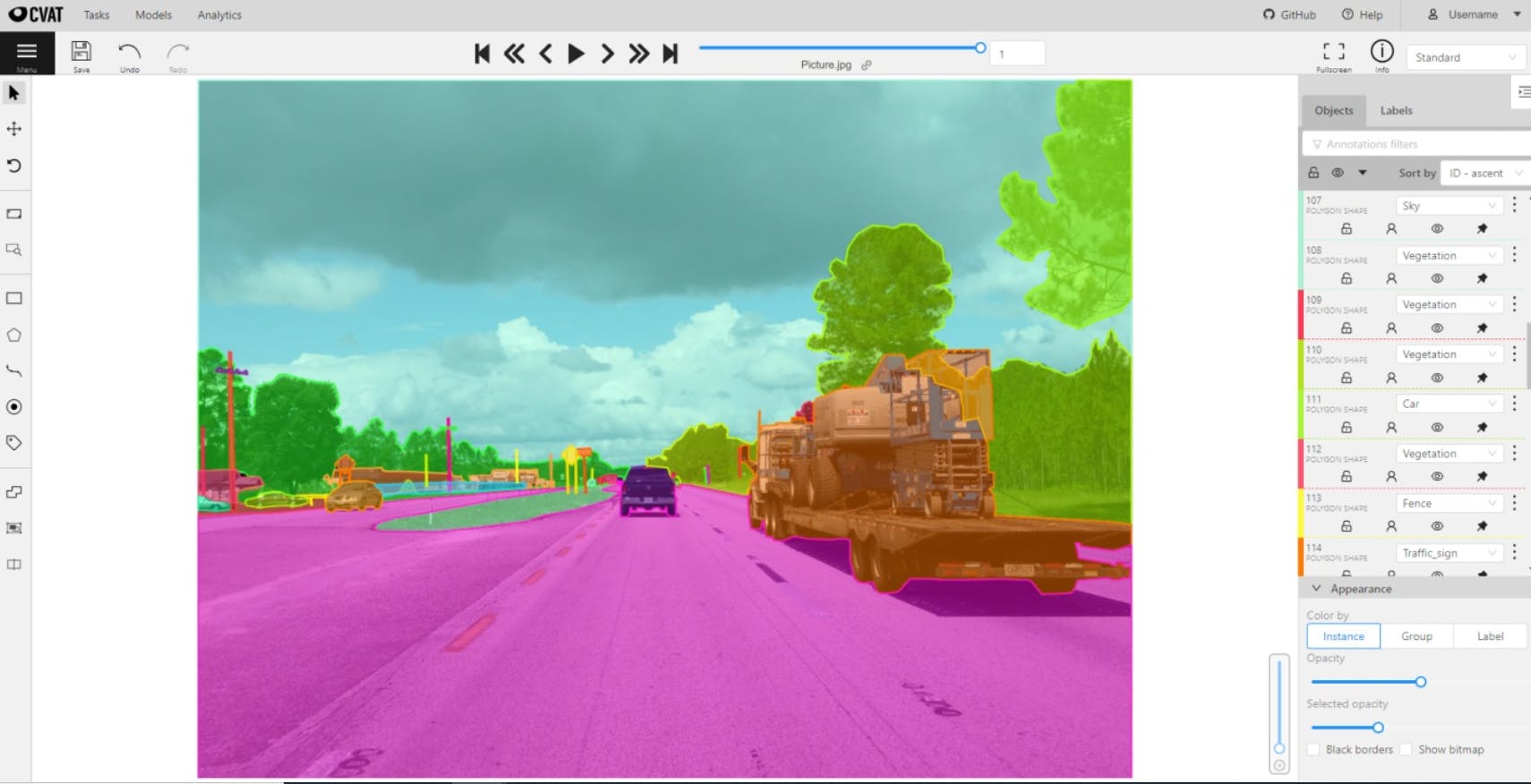
Key Features
- Affordability: CVAT offers a free version for personal and charges only USD 33 per month for professional and organizational use.
- Ease-of-use: The platform provides an easy-to-use interface with straightforward navigation and a clear workspace.
- Annotation Methods: The tool supports bounding boxes, polygons, polylines, points, ellipses, and cuboids.
Other Features
- Automation: You can use built-in CV models, such as YOLO v7 and Faster RCNN, to automatically label your data.
- Performance Monitoring: CVAT lets you monitor annotation quality through a performance dashboard featuring metrics like objects labeled per hour, object count, timelines, etc.
Best For
- Beginners looking for a lightweight annotation tool to create basic CV applications.
Pricing
- CVAT offers a free, Solo, and Team version.
9. Superb AI
Superb is an AI platform that offers multiple tools to curate and label data. It also helps with model training and deployment, providing apps to automate AI workflows.
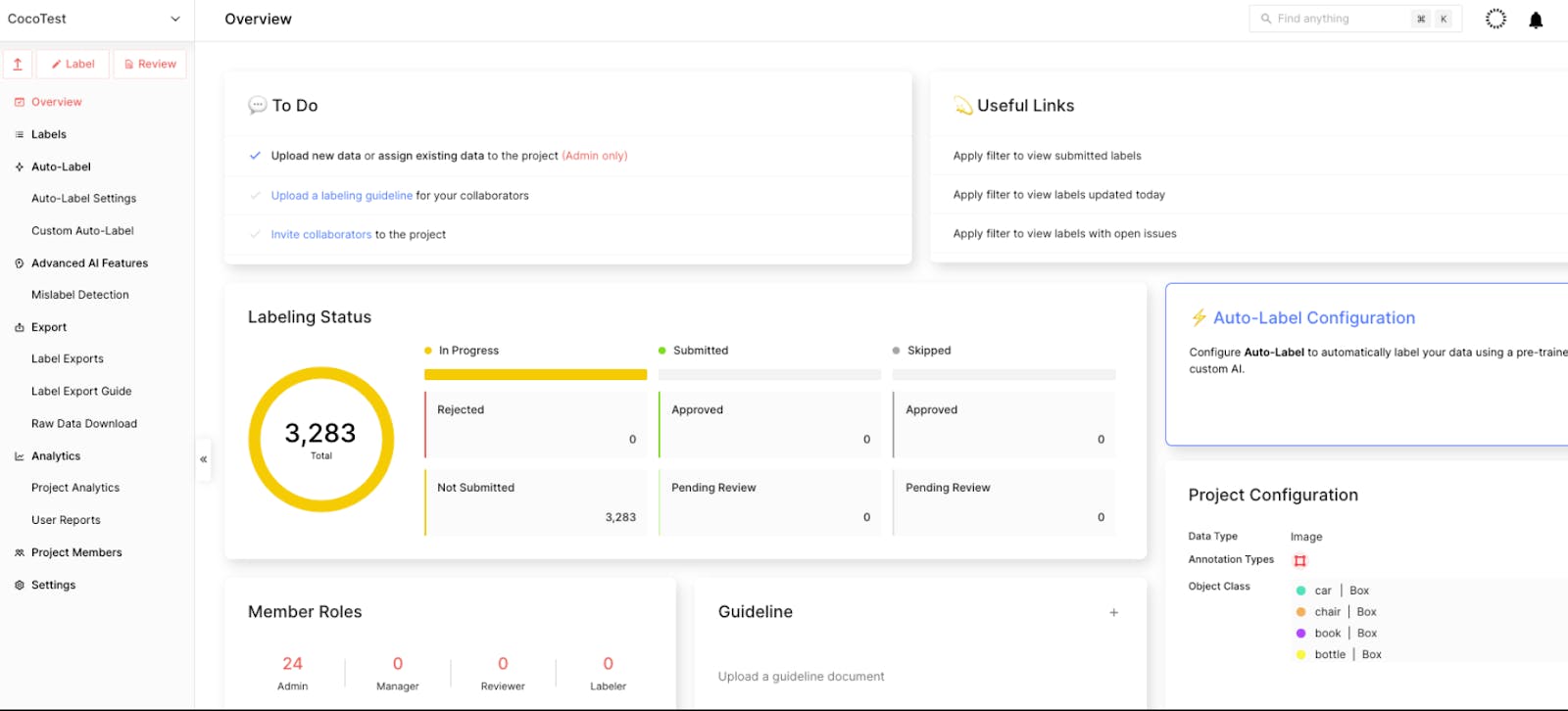
Key Features
- Ease-of-use: The tool features a straightforward UI with clearly organized sections highlighted with self-explanatory options.
- Annotation Methods: Superb Label supports bounding boxes, polygons, polylines, key points, and cuboids.
Other Features
- Automation: The Auto-Label feature lets you annotate everyday objects using a pre-trained model that is available out of the box.
- Data Curation: Superb Curate generates data clusters based on embeddings to help users organize their data assets more efficiently.
- Superb Model: Superb Model provides a complete no-code solution to train and deploy baseline models using data curated through Superb Curate.
Best For
- Teams looking for a solution to manage complex data.
Pricing
- Pricing is not publicly available.
10. SuperAnnotate
SuperAnnotate is an AI platform for building LLMs and Gen AI models through a user-friendly interface. It also includes annotation tools to label images, videos, text, and audio.
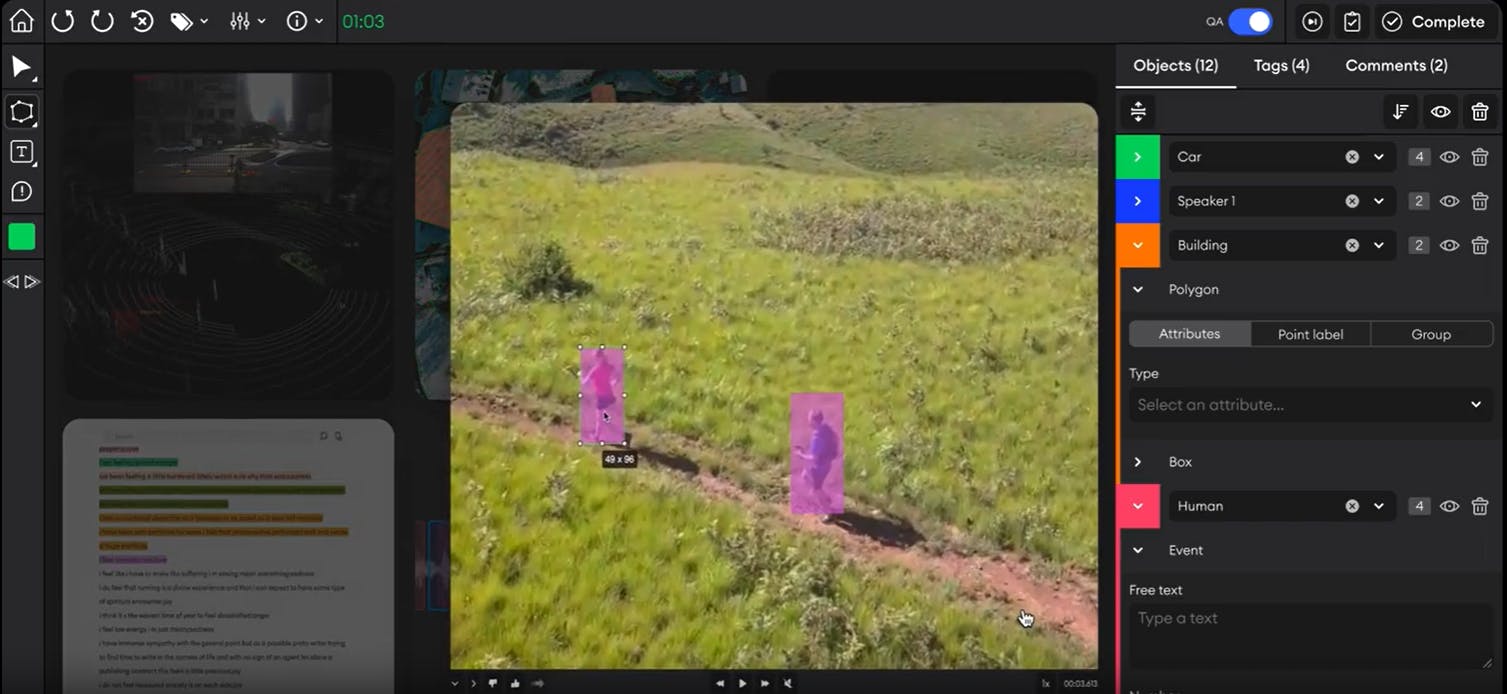
Key Features
- Affordability: SuperAnnotate’s free version offers sufficient features for startups and independent researchers to work on standalone projects.
- Ease of use: The platform’s UI offers guided steps for building efficient LLMs and Gen AI frameworks.
- Annotation Methods: The tool supports bounding boxes, key points, segmentation masks, OCR annotation, speech recognition, and sound event detection.
Other Features
- Data Curation: SuperAnnotate lets you create data subsets and query relevant items through advanced filtration and visualizations.
- Automation: The tool enables you to build automated pipelines to manage annotation projects at different stages of the development lifecycle.
Best For
- Teams looking for a platform to orchestrate LLMs and Gen AI model development.
Pricing
- Pricing is not publicly available.
11. Segments.ai
Segment.ai is a data labeling tool that annotates multi-sensor data through a single interface by combining 3D point clouds and 2D image data.
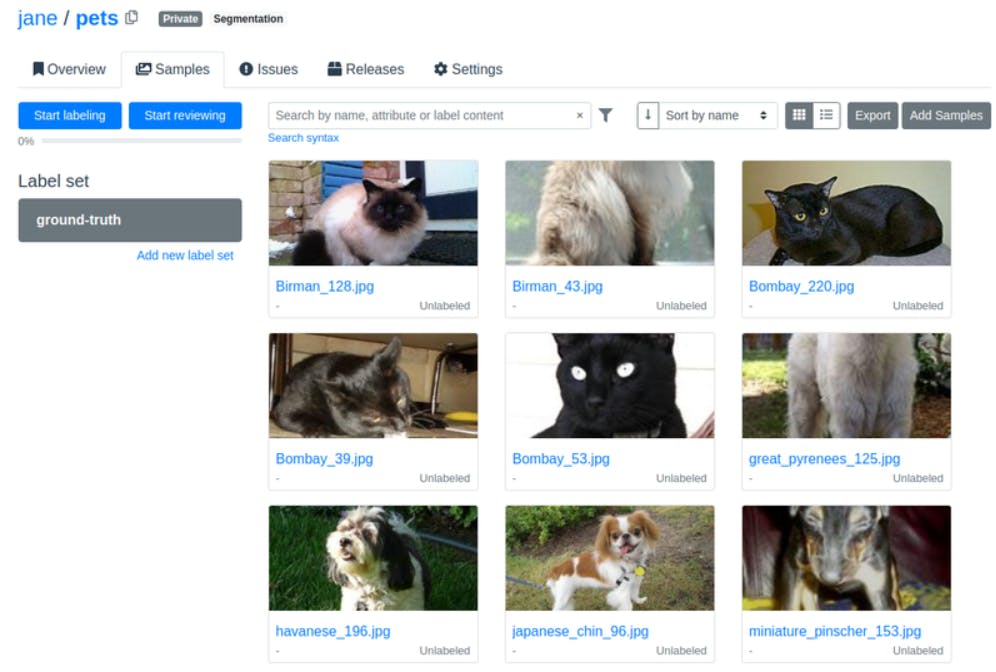
Key Features
- Affordability: The tool is suitable for large organizations that collect data from multiple sensors and edge devices.
- Ease-of-use: The platform features intuitive interfaces to label 2D and 3D image data.
- Annotation Methods: Segments.ai supports bounding boxes, cuboids, segmentation masks, polylines, polygons, and key points.
Other Features
- 3D to 2D Projection: The platform allows you to project 3D cuboids on 2D bounding boxes for greater labeling accuracy.
- Sensor Fusion: The tool lets you combine data from multiple sensors and label them through a single interface.
- Moving Object Annotation: Segments.ai supports real-time interpolation and ML-based object tracking to annotate moving objects.
Best For
- Teams looking for an advanced solution for labeling sensor data.
Pricing
- Segments.ai offers a Team, Scale, and Enterprise version.
12. LabelBox
LabelBox is a data management solution that lets you curate and label unstructured data using pre-trained foundation models to automate the annotation process.
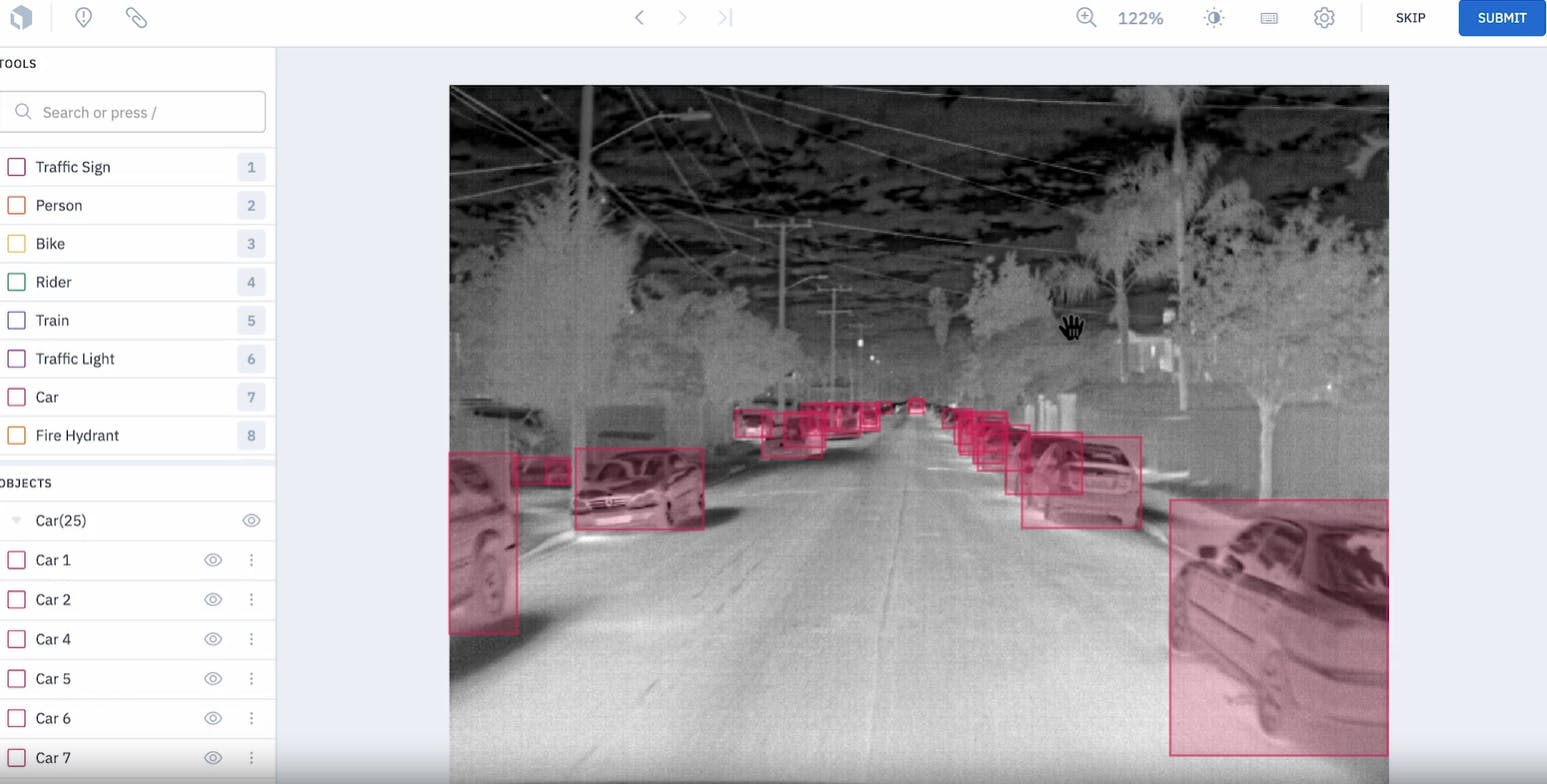
Key Features
- Affordability: LabelBox offers a free version for individuals and a Starter version that charges USD 0.1 per LabelBox unit.
- Ease of use: The tool features user-friendly interfaces for exploring and visualizing datasets, annotating data items, and evaluating model outputs through intuitive dashboards.
- Annotation Methods: LabelBox supports bounding boxes, segmentation masks, polygons, polylines, and cuboids.
Other Features
- Workflows: The tool lets you create custom pipelines to review and monitor annotation progress.
- Foundry: LabelBox uses Foundry, which consists of foundation models to predict labels and allows you to compare the performance of different models.
Best For
- Medium-sized enterprises looking for a cost-effective labeling solution for CV and NLP tasks.
Pricing
- The tool offers a Free, Starter, and Enterprise version.
Supervisely Alternatives: Key Takeaways
AsCV and NLP models become integrated into every aspect of business operations, investing in a scalable AI platform is becoming a strategic necessity to stay ahead of the competition.
Below are a few points to remember regarding such AI platforms.
- Supervisely’s Limitations: While Supervisely is a comprehensive solution to manage data and build models, it is expensive and only suits organizations with extensive cloud-based infrastructure.
- Essential Factors: Businesses and researchers should consider a tool’s total cost of ownership, which includes its upfront costs and maintenance expenditures. Further, they must determine its ease of use and ensure it covers all the necessary features to handle the ever-evolving data volume and variety.
- Supervisely Alternatives: Encord, SuperAnnotate, and Kili are a few cost-effective, easy-to-use, and feature-rich alternatives to Supervisely.
Explore the platform
Data infrastructure for multimodal AI
Explore product
Explore our products
- Computer vision models are algorithms that process and understand visual information.
- The key challenges include a lack of high-quality training data, annotation complexity, model deployment, and scalability.
- Computer vision platforms provide the necessary annotation tools to label complex datasets, automation tools to streamline the labeling pipeline, and data management features to store and search relevant data for specific use cases quickly.
- Common types include bounding boxes, cuboids, key points, polylines, polygons, and segmentation masks.
- Encord, SuperAnnotate, and Kili are the best alternatives to Superivsely.
- Yes. All these platforms offer APIs and Python SDKs to build custom models and pipelines.
- The tools offer extensive annotation methods, an easy-to-learn user interface, and content moderation and generative AI frameworks to enhance AI applications.


